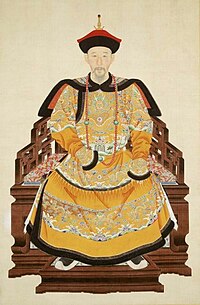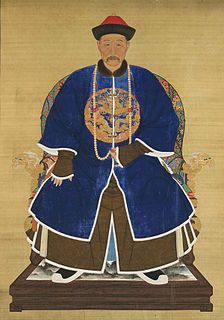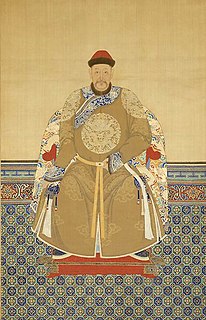| Yinxiang | |||||||||
|---|---|---|---|---|---|---|---|---|---|
| Prince Yi of the First Rank | |||||||||
Portrait of Yinxiang | |||||||||
| Prince Yi of the First Rank | |||||||||
| Reign | 1722–1730 | ||||||||
| Predecessor | None | ||||||||
| Successor | Hongxiao | ||||||||
| Born | 16 November 1686 | ||||||||
| Died | 18 June 1730 (aged 43) | ||||||||
| Spouse | Primary spouses: Lady Zhaojia Lady Fuca Lady Wusu Lady Guwalgiya Secondary spouses: Lady Shijia Lady Nara | ||||||||
| Issue | Hongjiao Hongxiao Others | ||||||||
| |||||||||
| House | Aisin Gioro | ||||||||
| Father | Kangxi Emperor | ||||||||
| Mother | Imperial Noble Consort Jingmin | ||||||||
| Yinxiang | |||||||||
| Chinese | 胤祥 | ||||||||
|---|---|---|---|---|---|---|---|---|---|
| |||||||||
| Yunxiang | |||||||||
| Chinese | 允祥 | ||||||||
| |||||||||
Yinxiang (16 November 1686 – 18 June 1730) was a Manchu prince of the Qing dynasty. The thirteenth son of the Kangxi Emperor, Yinxiang was a major ally of his brother Yinzhen (that is, the Yongzheng Emperor) during the latter's struggle for the succession of the throne. He was made a qinwang (first-grade prince) during Yongzheng's reign and became one of his closest advisors. He died eight years into the reign of the Yongzheng Emperor and was memorialized with top honours by the emperor. When he died, his title was granted "iron-cap" status and became perpetually inheritable, one of the only twelve such princes in Qing dynasty history.
The Manchu or Manzu are an ethnic minority in China and the people from whom Manchuria derives its name. They are sometimes called "red-tasseled Manchus", a reference to the ornamentation on traditional Manchu hats. The Later Jin (1616–1636), and Qing dynasty (1636–1912) were established and ruled by Manchus, who are descended from the Jurchen people who earlier established the Jin dynasty (1115–1234) in China.

The Qing dynasty, officially the Great Qing, was the last imperial dynasty of China. It was established in 1636, and ruled China proper from 1644 to 1912. It was preceded by the Ming dynasty and succeeded by the Republic of China. The Qing multi-cultural empire lasted for almost three centuries and formed the territorial base for modern China. It was the fifth largest empire in world history.

The Yongzheng Emperor, born Yinzhen, was the fourth emperor of the Manchu-led Qing dynasty and the third Qing emperor to rule over China proper. He reigned from 1723 to 1735. A hard-working ruler, the Yongzheng Emperor's main goal was to create an effective government at minimal expense. Like his father, the Kangxi Emperor, the Yongzheng Emperor used military force to preserve the dynasty's position. His reign was known for being despotic, efficient, and vigorous.













